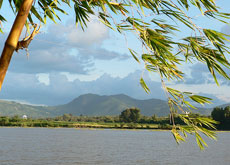To ethnic people in the highlands the Dak Bla River, the nation’s only river with backward flow, remains the one constant in the ever-changing world.

Starting from the upper reaches of Polei Breng then down stream to Yaly, Kon Yum, Dak Bla (big river in the Ba Na people’s language) silently embraces memories as well as cultural relics of the ethnic groups of Ba Na, Jao Rai, Xe Dang, Ro Mam or Ro Ngao.
The river flows from east to west and spans through Kon Tum City which is famous for its wooden church. The wooden church was built by a French priest named Guise Decrouille in 1913, with hundreds of cubic meters of high-quality wood such as rose-wood and ca chit, a valuable wood that once grew in abundance across the Central Highlands but rare these days.
The church’s architecture combines Roman and Gothic arches with Central Highland features. The whole structure stands one meter above the ground on wooden pillars.
As you leave the church, crossing Dak Bla on the bamboo bridge Kon Klor, you will step upon Kon Klor Village, home of the Ba Na people.
Kon Klor, the most beautiful suspension bridge in the highlands, is considered as a conduit linking urban culture to village culture. Next to Dak Bla River in early morning or under the sunset, dozens of ox carts carry farming products across the stream under the glistening sunlight. The wooden boats are the oldest means of transport for locals; they are simple and reliable and change is not needed for these people.
Leaving Kon Klor Bridge in the opposite direction with the sun lighting over the Kong Muk Mountain, the river comes over Kon JoDri Village. The village is home to jodri (yellow apricot) flowers and many nha rong (long stilt homes of ethnic peoples). For the village, nha rong is its heart and soul as it preserves the sacred, spiritual and cultural values of locals.
With locals, nha rong is not only a communal house to gather the whole village for traditional ceremonies but also for children to come to learn more about culture and history as well as listening to stories from the older generations.
Tourists coming to nha rong not only have a chance to sleep in the ancient stilt house but also to become a local for a night or two and experience the colorful ethnic culture via dances, folk songs, gongs performances by the camp fire and sample some ruou can (wine drunk through bamboo pipes via a jar).